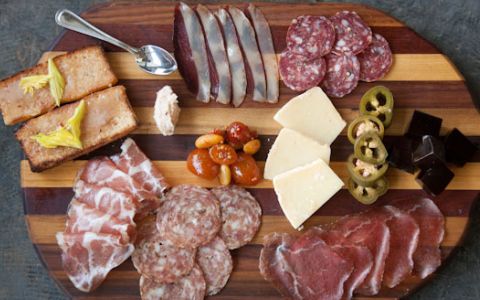When you think of charcuterie, you probably think of France, the very birthplace of the term, or Italy, with its famous salumi, or Spain, home of jamón.
The American South, though, has rightly earned its own place in the conversation, embracing the time-honored tradition of curing meats with more fervor and reverence than any place else on this side of the pond. Part of that is a natural extension of the region’s European heritage, a credit to the early French and Spanish settlers who brought their preservation techniques to the New World. But there are other cultural and practical reasons as well.
We spoke with some of the South’s most successful and talented charcuterists to find out how and why they have cornered the market on preserved meat.

Hog Heaven
There’s a fundamental reason why charcuterie is so well suited to the Southern palate, and it comes with four legs and a squiggly tail.
“Pig reigns supreme in the South,” says Craig Deihl, executive chef at Cypress and Artisan Meat Share in Charleston, South Carolina. “Why do you think Southern barbecue is so hot right now? We have embraced pork a lot longer than other regions.”
In fact, the two top pork-producing counties in the entire country, according to the U.S. Department of Agriculture, are located in neighboring North Carolina, just a few hours up the coast from Diehl’s restaurants.
“Our customers eat a lot of pork, and they primarily want the chops and the belly, so the leftovers lend themselves to charcuterie,” says Deihl.
Even halfway across the country, in Texas, charcuterie’s popularity has a lot to do with the availability of product. “It goes back to the farmland in our region,” says Chris Shepherd of Underbelly in Houston. “We have accessibility to whole hogs, and we have farmers who are willing to grow specific breeds that are better for curing.”

Historic Habits
Culturally speaking, Southerners have a long tradition of eating preserved meat in all its forms, not just the kind served in esteemed restaurants on rustic wooden planks with those precious little forks. “We grew up eating country ham, and beef jerky and Slim Jims,” says Sean Brock, executive chef of Charleston restaurants Husk, McCrady’s and Minero, among others. “There’s a lot of overlooked charcuterie in Southern gas stations. There are certain salty and funky flavors that become ingrained in your DNA. Salt, sugar, red and black pepper generate cravings.”
Much of that acquired taste for cured meat is rooted in history. “In the South, we’re accustomed to cured products like ham, bacon, head cheese and souse because we come from a peasant background, unlike the more opulent settlers up North,” says Michael Sullivan, a butcher and former head of charcuterie at the acclaimed Blackberry Farm resort in Walland, Tennessee, who currently serves as regional sales manager for prominent beef supplier Creekstone Farms. “In Europe, charcuterie has always thrived in the peasant areas because they were forced to use the whole animal. It was a matter of necessity for survival.” He continues, “In New York, diners are still used to steaks and chops as a primary dish, but in the South people have always had to preserve their meat and stretch out their supply. Luckily, the preservations of adding salt and smoke also lead to flavors that aren’t prevalent in fresh meat. They are flavors that you don’t get from just cooking meat.”
Sullivan points out another important cultural distinction that goes back to the regions of Europe where colonial explorers came from. “Northern settlers were looking to set up shops and establish their own homesteads on the land, unlike some of the earliest Southern immigrants, like the Spanish, who were here to conquer, not to farm,” he says. “So the Spaniards had to find ways to preserve meat so that it was easily portable and lasted longer.”
“We grew up eating country ham, and beef jerky and Slim Jims. There’s a lot of overlooked charcuterie in Southern gas stations.” —Sean Brock, Husk
The basic curing process simulates the traditional hanging up of hams in the winter by regulating salt content, pH and temperature over the course of time. Historically, the curing of hams was done around Thanksgiving because farmers had time to do it after the crops were in for the winter, and if you didn’t slaughter your animals before the weather got cold, they would literally eat you out of house and home since there were no green pastures to feed them on. “Animals actually lose weight over the winter trying to stay warm,” explains Sullivan, “and that’s the last thing you want from a pig or cow that you intend to eat eventually.”
The resulting cured meats also represented a quick and easy meal when farmers were busy working their land. A midday meal of country ham or bacon with beans and greens flavored with pig fat recharged the farmhands’ batteries the same way a simple lunch of preserved back fat lardo smeared on bread kept Italians laboring in the marble quarries.
Today’s chefs embrace the world of charcuterie as a remembrance of the past, in both process and flavors. “If you grew up on country ham, you adjust to the saltiness of the meat,” Sullivan explains. “As opposed to most of Europe, the South has a much warmer environment, so you need to use more salt to make sure the meat cures. Then we balance that with sugar, which is why [noted pork purveyor Allan] Benton’s bacon is saltier and sweeter than, say, Nueske’s.”

Dollars and Sense
Beyond history and local sourcing, there’s another reason why so many Southern chefs have embraced charcuterie programs. And that has to do with money. Restaurants are businesses, after all — and ones with notoriously tight profit margins. In so many ways, curing meats just makes good sense.
“Every time you have somebody else put a knife to something, you lose money,” says Sullivan, whose current role with Creekstone Farms involves educating restaurant operators about taking greater control of their meat programs, partially through the use of charcuterie. He is an advocate of kitchens adding a butcher program to use whole animals, pointing out that the cost savings from buying meat at a lower per pound rate and the higher yield of whole-animal utilization can more than pay for the labor costs of adding an extra employee to break down the animals. “If someone else sells you butchered meat, they get to keep the byproduct and then they charge you for it in the form of sausage or ground meats,” says Sullivan.
Deihl saw that advantage early in his restaurant career, but he’s also pragmatic about the process. “My philosophy is to source the best ingredients that make sense economically, and we’re not going to produce something ourselves unless we can make it better than we can buy it. Many people don’t want to think about it that way, but at the end of the day we’re running a restaurant.”
In addition to saving money and reducing waste, Shepherd sees his butchering and charcuterie processes as a way to stimulate creativity. “I don’t want my cooks to just serve the middle of the plate chops and grind the rest of the meat. I want them to have to figure out menu items using the rest of the animal. My kitchen staff is getting better because of having to think more about that.”

Local Flavor
Southerners are a proud people. Southern chefs are no different, and for many of them, charcuterie is an excellent vehicle to promote the stories of the region’s history and geography.
“All charcuterie comes from what’s in the backyard,” says Sullivan, who points to the classic Toscano salumi as an example. In Tuscany, Italy, salumi is commonly flavored with rosemary, thyme, garlic and red wine. “Because that’s what they harvest every single year,” he says. “It just makes sense.” Other regions of Italy spotlight different ingredients in much the same way, he notes. In Calabria, the abundant peppers make their way into the ‘nduja grind for an even spicier sausage paste.
In terms of the American South, Sullivan points to the example of souse and head cheese to tell a tale of how food evolved as it made its way to and through the region. These fresh sausages came to Louisiana through the Cajuns, who torqued up the mild French souse with the addition of local peppers. The English version of souse showed up in the Carolinas first, more gelatinous than its Cajun cousin. The early Carolinians added vinegar and chili flakes to the grind, a combination of flavors that eventually would come to characterize their version of whole hog barbecue sauce.
As both the mutated Louisiana/French and Carolina/British versions of souse migrated with settlers to Tennessee, they entered a region that emphasized corn over rice, the grain that Cajuns used as a filler to stretch the yield in their boudin. For better or for worse, Tennesseans boiled their pigs’ heads to harvest the last vestiges of meat on the carcass and combined the slurry with a cornmeal mush to form patties that were then fried up in a skillet for an authentic mountain breakfast dish.
“All charcuterie comes from what’s in the backyard.” —Michael Sullivan, Creekstone Farms
Brock still believes that charcuterie should reflect the ingredients in the area where it is made. “You need to showcase the animal breeds and farmers from your region,” he says. “It’s important to glorify your food sources and create a product that demonstrates simplicity and individuality in that it can only be made there.” Brock has done a lot of thinking about what sort of cured meats he should be making in his restaurants in Charleston and Nashville. “What does a Low-Country ham taste like? You have to stand in your town and figure out what it tastes like and utilize your geography to contribute individuality.”
Both Brock and Deihl use sea salt from Charleston in their cure recipes to give their products some connection to where it’s made, but Shepherd is looking more to the immigrant population of his changing city for inspiration and recipes. “I’ve started a salumi series focused on Houston and based on where we’re at now, so I’m moving beyond just old-school Italian. I’m curing meats with spices from India, Vietnam, China and Mexico. I’m going for both a sense of place and a sense of time.”
Brock even uses charcuterie as a litmus test to judge a restaurant when he visits. “It’s a craft of your hands, of repetition, and it requires patience,” he says. “Great charcuterie comes from a responsible chef working with whole animals. You know that you’re in a restaurant that gives a shit and knows what they’re doing. If they can do that, they can certainly roast a fish!”



